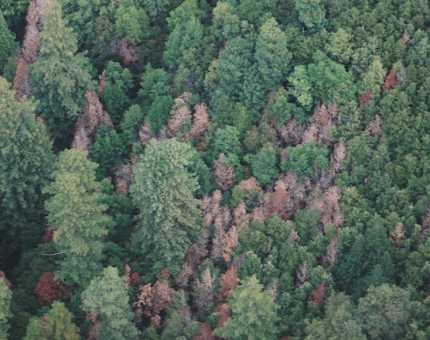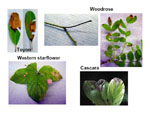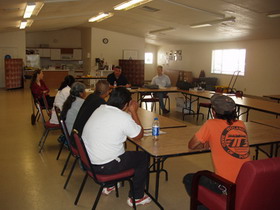 The establishment of P. ramorum in the California and Oregon wildlands has serious ecological, cultural, and community impacts for American Indians from these regions. Among the most serious of the threats is loss of highly valued acorn-producing trees (oak and tanoak) in traditional gathering areas. Others are concerned about how P. ramorum-influenced ecological change will influence the amount and quality of basket weaving materials. Tribal members fear that changes caused by this exotic disease may be devastating to traditional culture resulting in loss of passing down of lifeways to the next generation. More study is needed to fully understand the extent of the impact on these culturally valuable plants. Various other native plants, many equally important to tribes, are susceptible to infection by P. ramorum. While generally P. ramorum infection is not lethal to most native plant hosts used by tribes, moving infected plants could contribute to disease spread. Below are resources related to common tribal concerns, as well as resources on how to identify the symptoms of P. ramorum on native plants and reduce the risk of spreading the pathogen.
The establishment of P. ramorum in the California and Oregon wildlands has serious ecological, cultural, and community impacts for American Indians from these regions. Among the most serious of the threats is loss of highly valued acorn-producing trees (oak and tanoak) in traditional gathering areas. Others are concerned about how P. ramorum-influenced ecological change will influence the amount and quality of basket weaving materials. Tribal members fear that changes caused by this exotic disease may be devastating to traditional culture resulting in loss of passing down of lifeways to the next generation. More study is needed to fully understand the extent of the impact on these culturally valuable plants. Various other native plants, many equally important to tribes, are susceptible to infection by P. ramorum. While generally P. ramorum infection is not lethal to most native plant hosts used by tribes, moving infected plants could contribute to disease spread. Below are resources related to common tribal concerns, as well as resources on how to identify the symptoms of P. ramorum on native plants and reduce the risk of spreading the pathogen.
Tribal Resources
- A Guide for Tribal Plant Gatherers: Simple Precautions to Prevent the Spread of Sudden Oak Death
- Sudden Oak Death: Issues for Traditional Plant Gatherers
- Collection and Care of Acorns: A Practical Guide for Seed Collectors and Nursery Managers
- Native Plant Symptoms Slideshow
- Native Plant Fact Sheets
- Frequently Asked Questions
- An Exploratory Study of the Nutritional Composition of Tanoak (Lithocarpus densiflorus) Acorns after Potassium Phosphonate Treatment. By K. Meyers, T. Swiecki, and A. Mitchell
- Understanding the Native Californian Diet: Identification of Condensed and Hydrolyzable Tannins in Tanoak Acorns (Lithocarpus densiflorus). By K. Meyers, T. Swiecki, and A. Mitchell
Native Plant Symptoms
Many native plants have minor, non-lethal symptoms, but can still contribute to the spread of  the pathogen. Having familiarity with the symptoms of P. ramorum as they appear on important and commonly collected native plants can reduce risk of moving infected plant materials. See a slideshow of photos were compiled by Janice Alexander (UCCE Marin) and were provided by John Bienapfl (UC Davis).
the pathogen. Having familiarity with the symptoms of P. ramorum as they appear on important and commonly collected native plants can reduce risk of moving infected plant materials. See a slideshow of photos were compiled by Janice Alexander (UCCE Marin) and were provided by John Bienapfl (UC Davis).
Native Plant Fact Sheets
Each of the following fact sheets features a native plant that is associated with P. ramorum and describes its use by California Indians. These fact sheets were created and provided by Robert Clement with support from USDA.
Frequently Asked Questions
Will I become sick from ingesting foods and products from plants that are infected with P. ramorum?
There is no evidence to suggest that ingesting products (e.g. food, medicine, etc.) from host material that is infected with P. ramorum, such as nuts, fruits, leaves, or berries, poses a health risk to humans. Related discussion on this topic can be found in Beverly Ortiz’s article; Contemporary California Indian Uses for Food of Species Affected by Phytophthora ramorum.
What is the likelihood of spread of SOD by gathering host plants for cultural use?
Cultural use of native plants is important and should not be mired by the fear of spreading the pathogen. However, there is legitimate cause to use caution and follow the recommended best management practices when gathering plants. Widespread gathering of plants for cultural purposes has the potential to move the pathogen great distances and increase the likelihood of disease spread.
In brief, being familiar with the symptoms of Sudden Oak Death on oaks and tanoaks as well as California bay laurel is the best way of knowing if the disease is in a gathering site and important in preventing further spread. For more information on where and when to go and how to prevent spread see the recommendations in the best management practices.
When known host plants are gathered and processed for cultural purposes, what are the recommended precautions that I can take to prevent spreading SOD?
-
- Drying, heating, or cooking plant material at high temperatures kills the organism and reduces the risk of spreading the disease.
- If possible, process and cook or dry the material as soon as possible. When storing material, keep it dry and out of any standing water. Remember that the pathogen prefers moist/wet areas and cool temperatures, so avoid keeping host material in such conditions.
- If host plant material is soaked, such as in basket making or food preparation, the water and other waste materials can become contaminated. Boiling the water will kill any organisms and reduce the risk of spread.
- If bark is stripped or other parts are not used, burn the excess materials if possible. If burning is done, make sure it is done in a safe and approved manner. Burning poses no risk of spreading the pathogen since the organism is killed in the fire.
(Excerpted from the Best Management Practices)
How do the approved preventative treatments, phosphonate application, for oaks and tanoaks impact acorn nutrition and properties?
Tanoaks and some oak species have been heavily impacted by P. ramorum, raising concerns about future collection and use of acorns. While many tribes would like to protect the oaks and tanoaks that they traditionally use for acorn gathering from P. ramorum, they are also concerned that application of potassium phosphonate to tanoak trees may detrimentally affect the nutrient composition of the acorns produced by the trees. One research study on tanoak acorns provided results that suggest that the variation in acorn composition between individual trees and between years appears to be greater than variation associated with phosphonate application (Meyer, Swecki, and Mitchell 2007).

Outreach for Tribes
To address the needs of California Tribes in dealing with P. ramorum, the COMTF has worked in cooperation with tribal members on outreach efforts. We continue to seek opportunities to address tribal educational needs concerning P. ramorum. Resources such as the Sudden Oak Death Information Binder are available on our website.
Links
Modern preparation of wild foods – acorn processing and food preparation, California bay laurel nuts, and Douglas-fir and Yerba buena teas.
Phoebe A. Hearst Museum of Anthropology newsletter (Fall 2008) and website
Californian Department of Education – American Indian Education Centers, a directory of centers listed by county.
California Indian Basketweavers Association
Tribal Program Newsletter – United States Environmental Protection Agency


